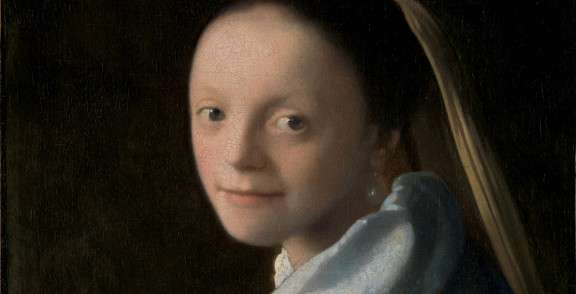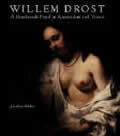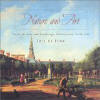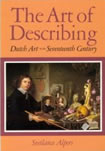By purchasing books via any of the Amazon.com or Amazon.uk links below, you will be contributing to the growth and maintenance of Essential Vermeer website, obviously, at no additional cost to your purchase.
An accessible introduction to Dutch paintings of the seventeenth century, illustrated with fifty of the finest works from the Royal Collection London.
Frankly intended as an overview of Dutch painting for the interested layman, Christopher Lloyd's catalogue of the exhibition is designed in an attractive, small format, loaded with good color reproductions and well-priced. The catalogue begins with a short chapter called "The critical eye: Dutch paintings of the Golden Age," which gathers together quotes about Dutch painting by commentators from Van Mander to Simon Schama. Lloyd then provides an introduction, covering basic information about the history of the United Provinces, the development of Dutch painting in a very general sense, and its critical reception (particularly in Britain), closing with a brief discussion of the "recent upsurge in interest in Dutch seventeenth-century painting." Succinct entries for the paintings on display, largely drawing on existing scholarship and with a reference to Christopher White's catalogue of the collection.
Willem Drost (1633–1659) was one of Rembrandt's most gifted pupils, and he is also considered one of the most mysterious. This book, the first ever devoted to this exceptional artist, unravels many of the mysteries of Drost's life and career. Curator and art historian Jonathan Bikker offers not only new archival evidence of the artist's date and place of death, but also a new assessment of Drost's place in the Rembrandt workshop and in the Venetian art world of the mid-seventeenth century. Drost emerges as one of Rembrandt's most talented imitators and, despite his short career, an artist with a variety of faces.
The book features a meticulously researched and fully illustrated catalogue raisonné with 38 paintings now attributed to Drost (several formerly attributed to Rembrandt) and 35 other paintings today known only from old sale catalogues or reproductions. The author also discusses 32 paintings he rejects as Drost's work.
Portraits of the Mauritshuis 1430–1790
edited by Quentin Buvelot, essays by Ben Broos, Ariane van Suchtelen. With contributions by Quentin Buvelot, Guus Sluiter, Petria Noble, Peter van der Ploeg, Hans Vlieghe and Frederik Duparc with an introductory essay by Rudi Ekkart.2004

In this handsome catalogue, more than 230 painted portraits from the renowned collection of the Mauritshuis are reproduced and described. Besides portraits by the three great masters of seventeenth-century Dutch portraiture, Rembrandt, Hals and Vermeer—including world famous works such as The anatomy lesson of Dr. Nicolaes Tulp and Girl with a pearl earring—many other paintings from the fifteenth to the eighteenth centuries are presented. They included masterpieces by Flemish masters such as Van Dyck and Rubens, and even some rare portraits by Holbein and Memling.
In the first part of this large and attractively designed catalogue, 60 portraits are discussed in great detail, while the second part contains concise entries of over 170 other paintings. The introductory essay discusses the genesis of this fascinating collection and points out relationships between a number of the portraits it contains.
In this study of Amsterdam's Golden Age cultural elite, John Michael Montias analyzes records of auctions from the Orphan Chamber of Amsterdam through the first half of the seventeenth century, revealing a wealth of information on some 2,000 art buyers' regional origins, social and religious affiliations, wealth and aesthetic preferences. Chapters focus not only on the art dealers who bought at these auctions, but also on buyers who had special connections with individual artists.
An Entrance for the Eyes: Space and Meaning in Seventeenth-Century Dutch Art
by Martha Hollander2002

Martha Hollander's lively and gracefully written book considers one of the most intriguing features of seventeenth-century Dutch painting: the pictorial language of space, in particular the use of secondary scenes. Many Dutch pictures, especially genre scenes and portraits, introduce a gap through the trees; a view of distant mountains; views through windows, archways, open doors, and pulled-back curtains; or mirrors and pictures-within-pictures to comment on, explain and enrich the primary scene that unfolds on the canvas. Hollander uncovers the meanings generated by the formal structure of such pictures, tracing their heritage in the medieval and Renaissance pictorial traditions of illuminated manuscripts, emblems and stage design. A number of Dutch painters, working for a fiercely competitive art market fostering experiment and novelty, created these secondary scenes in remarkably various and inventive ways. An Entrance for the Eyes focuses on striking features in the works of several artists who carried out bold experiments with space and meaning. Hollander introduces the ideas of pictorial organization formulated by Karel van Mander in both his paintings and his theoretical treatise Het Schilder-boeck. She explains how Gerard Dou (1613–1675), in his tightly constructed allegorical pictures, particularly those set in niches, used the secondary space to comment on the figure in the foreground.
Pride and Joy: Children's Portraits in the Netherlands, 1500–1700
by Jan Baptist Bedaux & Rudi Ekkart2001

The wonderful portraits of children that Dutch and Flemish artists painted in the late Renaissance and Baroque periods offer a fascinating look not just at the youngsters themselves—along with their clothes, toys and pets—but also at the society in which they lived. The charming pictures in this unique book demonstrate that 500 years ago children were, as they are now, their parents' pride and joy.
At first glance, these young people in their elaborate clothing and fancy headgear hardly resemble modern youth. But their fresh faces and vivid expressions transcend time. Superb full-page colorplates reproduce 85 of the best of these portraits—by famous and lesser-known artists alike—while essays by leading art and cultural historians set them in context. Countless parents have formal portraits or studio photographs made of their children. For them, as well as for art lovers and students, Pride and Joy should hold an irresistible fascination.
In its golden age, according to Erik de Jong, Dutch landscape architecture constituted a major, distinct phase in the European development of the art. In Nature and Art, de Jong examines five garden reconstructions—Het Loo, Heemstede, Zijdebalen and the medicinal gardens of Leiden and Haarlem—within their unique cultural and geographic framework in order to establish the historical importance and singularity of Dutch garden art.
Interest in geometric gardens was shared by all strata of Dutch society from courtiers to burghers; paintings, travel books, and poetry of the period contain evidence of the landscape garden's popularity. While the Dutch professed an ideal of outdoor life, in reality it was not nature that held sway, but rather design, which subjected nature to the rules of art. The garden was not so much a place of solitary retreat as a work of art through which to reveal oneself to the outside world. De Jong sets specific Dutch creations on the European map alongside the works of Le Notre in France, and argues for their independent identity in a rival tradition of equal importance.
The Golden Age of Dutch Art: Painting, Sculpture, Decorative Art
by Judikje Kiers & Fieke Tissink2000

Masterpieces of Dutch art from the seventeenth century: this sumptuous survey illuminates the extraordinary richness and versatility of the art produced in Holland in the seventeenth century of the Dutch Golden Age. It is published on the occasion of an ambitious exhibition organized to celebrate the bicentenary of the Rijksmuseum in Amsterdam. Paintings, drawings, prints, sculpture and the decorative arts: more than 200 works of art have been carefully selected from the extensive holdings of the Rijksmuseum and from museums and private collections around the world. The paintings and drawings—portraits, landscapes, still lifes, genre painting, history painting—include masterpieces by the renowned painters Hals, Rembrandt, Ruisdael, Steen and Vermeer. The applied arts are represented by exquisite examples of Delftware, silver by the brothers van Vianen, tapestries by Francois Spiering, and more. The accompanying text describes in detail the development and accomplishments of Dutch art in the seventeenth century. With its wealth of illustrations and extensive reference section, The Golden Age of Dutch Art provides the most comprehensive overview possible of this seminal period in Western art.
Building on Weber's notion that Protestantism fosters the accumulation of wealth, Larsen argues that social and economic forces influence the form, style and content of art. To demonstrate his point, he provides a compelling analysis of the creation of art in the Netherlands during the seventeenth century. He examines how growing capitalism spawned a wealthy middle class that shaped Dutch painting into a national style through its patronage. He contrasts this style with the Baroque school of Flanders to the south and explores the reasons behind the differences in artistic expression. Art Historians as well as other scholars interested in the social ramifications of capitalism will find much to their liking in this stimulating work.
A Moral Compass: Seventeenth and Eighteenth Century Painting in the Netherlands
by Arthur K. Wheelock, et al1999

Painting in the Netherlands during the seventeenth and eighteenth centuries offers a compelling visual record of the tastes and values of a prosperous society mindful of its obligation to personal and public standards. This richly illustrated volume examines twenty-six paintings by master artists from this Golden Age of Dutch art and features essays by leading scholars who explore the various interpretations of these works within the context of their culture.
Masters of light: Dutch Painters in Utrecht during the Golden Age
edited by Lynn Orr & Joaneath Spicer1998

This beautiful catalog presents a comprehensive treatment of the achievements of the Utrecht school of painters. Unlike their more well known compatriots, Rembrandt and Vermeer, who perfected naturalistic portraits of seventeenth-century Dutch cultural life, the Utrecht masters (including Abraham Bloemart and Cornelis van Poelenburch) infused their canvases with a blend of mythological imagination, baroque religiosity, and a Dutch sense of nature. Van Poelenburch's Landscape with the Flight into Egypt, which sets the biblical flight of Joseph and Mary against a vast seventeenth-century Utrecht landscape, is one of many examples of this distinctive artistic approach. The catalog also features eight scholarly essays on the sociopolitical milieu that gave rise to the Utrecht school. As a predominantly Catholic province, Utrecht proved both receptive to the Caravaggesque sensibilities of these artists and more generous in its patronage of their works than other parts of Protestant mercantile Holland. The writing is at times uneven, but overall this is a solid academic study that promises to broaden our understanding of Dutch art.
Praise of Ships and the Sea: The Dutch Marine Painters of the 17th Century
by Jeroen Giltaij & Jan Kelch1997

Delft Masters, Vermeer's Contemporaries: Illusionism Through the Conquest of Light and Space
by Michiel C. C. Kersten, et al1996

Dutch Paintings of the Seventeenth Century (The Collections of the National Gallery of Art Systematic Catalogs)
by National Gallery of Art (U.S.),by Arthur K. Wheelock
1995

From the hardships of a long and arduous war with Spain, the seventeenth-century Dutch seem to have drawn strength and expressed pride in their unique social and cultural heritage, especially in their art. Arthur K. Wheelock Jr., the Gallery's curator of northern Baroque painting, has carefully studied the Gallery's collection by masters of the Golden Age of Dutch art—notably Cuyp, De Hooch, Rembrandt, Ruisdael and Vermeer. The twenty-three paintings by Rembrandt and his school are elucidated by an essay on the question of attribution, while an appendix of artists' signatures amplifies and supports the author's wide-ranging discussions of this remarkably cohesive collection.
Rembrandt, Vermeer, Hals, Ruisdael, Cuyp, de Witte, van Goyen, van de Velde, Saenredam and de Hooch are just some of the painters whose works document the uniqueness, vitality and genius of seventeenth-century Dutch painting. It was an age of discovery of the natural world and of the everyday world. There was a new humanization of art and a rich and varied range of subject matter in Dutch painting of this period.
Madlyn Kahr describes and interprets this fascinating period as a whole and the different artists and their most notable works, providing a fresh appraisal and understanding.
Seventeenth-Century Dutch and Flemish Painting: The Thyssen Bornemisza Collection
by Ivan Gaskell1990

A catalogue of 128 paintings produced during this period in which the art of portraiture was transformed, religious imagery became extremely dynamic, and new genres were established. Ivan Gaskell has brought to his catalogue an exemplary finesse and attention to detail, coupled with critical judgment that is both cautious and acute.
The Dutch of the seventeenth century were the first Europeans to specialize in marine art, and the achievements of the celebrated Dutch masters attest to the vitality and enduring appeal of Dutch marine art. Mirror of Empire is a catalogue that accompanies a traveling exhibition sponsored by The Minneapolis Institute of Arts. It is the first survey in English of Dutch marine art of the seventeenth century and includes many of the works of both Willem Van de Velde the Elder and Willem Van de Velde the Younger. The catalogue focuses on paintings, drawings, prints, sea charts and related cartographical material, while stressing the relationships among marine art and, commerce and the tremendous significance of Dutch ship design. Mirror of Empire provides biographies of Dutch marine artists and contributors' essays on related topics that help explain the works of art within the larger historical context of their time period. These topics include the Dutch trade routes that ensured the Dutch Republic its preeminent position in seventeenth-century Europe, the design and function of Dutch ships, the iconography of Dutch marine paintings as found in Dutch genre pictures of the period, and the importance of Dutch cartography to Western civilization.
The Embarrassment of Riches: An Interpretation of Dutch Culture in the Golden Age
by Simon Schama1988

Despite Calvinist sermons on thrift, the Dutch upper and middle classes flaunted their wealth in the consumer paradise that was 17th century Hollandbut they lived uneasily with material riches. How the Dutch reconciled piety with their commitment to profits is just one of the conundrums explored in this cultural history by a Harvard professor. Netherlandic seafarers built a world empire in just two generations; the Dutch nation's precocious rise to power as presented here helps to explain their defensive patriotism, the mania of housewives for cleanliness and the ideal of the family as a miniature commonwealth. The Dutch urge to classify was evident in everything from their tulip classification system to paintings of children's games. Delving into customs, beliefs, popular art and quirks of behavior, Schama has fashioned a tour de force, a profound, unconventional and rewarding portrait of a people.
This influential work examines the influence of culture, science and technology on the art of Dutch painters, including Vermeer, Rembrandt and Rubens.
"There is no doubt that thanks to Alpers's highly original book the study of the Dutch masters of the seventeenth century will be thoroughly reformed and rejuvenated. . . . She herself has the verve, the knowledge, and the sensitivity to make us see familiar sights in a new light."
—E. H. Gombrich
Set high on a ridge in historic parkland less than five miles from Trafalgar Square, Kenwood is London's favorite "country house." Remodeled by Robert Adam in the eighteenth century, in 1928 it became the home of the Iveagh Bequest, a superb collection of old master paintings donated by Edward Cecil Guinness, First Earl of Iveagh. The collection includes Rembrandt's most celebrated self-portrait, one of only five Vermeer's in Britain, Gainsborough's Countess Howe, and classic works by Reynolds, Romney, Lawrence and Turner.
This handsome book is published to mark the seventy-fifth anniversary of the opening of the Iveagh Bequest and is the first new catalogue of the collection to be produced in fifty years. It discusses each work, revealing details about the portrait subjects, the social circumstances of each commission, and the way that art met the ambitions of artists, patrons, sitters and collectors. There are also two introductory essays that provide historical background. The Kenwood is the home of Vermeer's splendid late Guitar Player.
—Julius Bryant is chief curator at English Heritage.
In this richly illustrated book nine authors—historians and art historians—provide background information about socio-economical aspects of the province of Holland in the seventeenth century. Their leitmotiv is the bibliography of the painter Johannes Vermeer (1632–1675). This prompts examinations of the environment in which Vermeer lived and worked and a critical scrutiny of certain biographical data and accepted views on the painter. One question that arises is whether he really was the unrecognized genius or impoverished artist of popular opinion.
This book examines Vermeer's social background, his training, the professional rules he had to observe, the "market" for which he painted, the prices of his paintings and his income.















 or anything else that isn't working as it should be, I'd love to hear it! Please write me at:
or anything else that isn't working as it should be, I'd love to hear it! Please write me at: